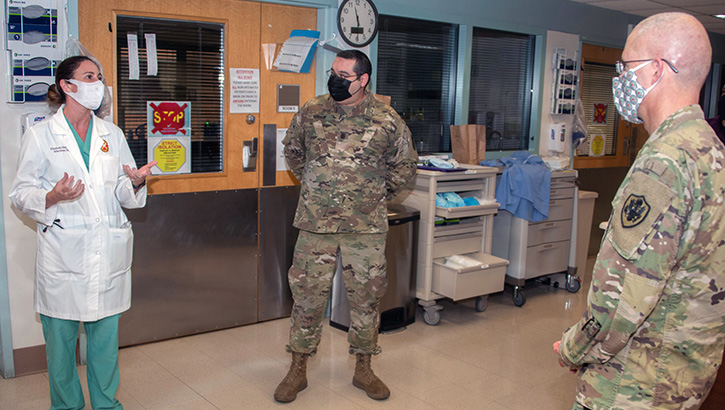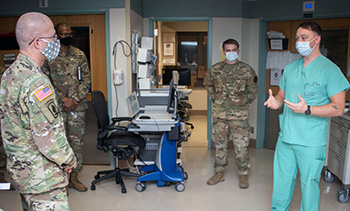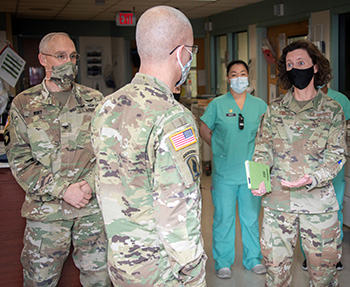DHA director visits San Antonio military units, JBSA vaccination sites
 Army Lt. Gen. Ronald Place, Director, Defense Health Agency, talks with Army Lt. Col. Elizabeth Markelz, Chief of Infectious Disease, and Army Lt. Col. Robert Walter, Chief of Pulmonary and Critical Care Medicine, at Brooke Army Medical Center, Fort Sam Houston, Texas, Jan. 20, 2021. Place said there is no location in DoD that has seen more COVID-positive cases or COVID-positive workload than the medical facilities at JBSA, lauding the relationship between the military health system here and their involvement in the community. (Photo by Jason Edwards.)
Army Lt. Gen. Ronald Place, Director, Defense Health Agency, talks with Army Lt. Col. Elizabeth Markelz, Chief of Infectious Disease, and Army Lt. Col. Robert Walter, Chief of Pulmonary and Critical Care Medicine, at Brooke Army Medical Center, Fort Sam Houston, Texas, Jan. 20, 2021. Place said there is no location in DoD that has seen more COVID-positive cases or COVID-positive workload than the medical facilities at JBSA, lauding the relationship between the military health system here and their involvement in the community. (Photo by Jason Edwards.)
Joint Base San Antonio’s role in Operation Warp Speed, the whole-of-nation response to COVID-19, and ongoing vaccination efforts were the highlight of a visit by Army Lt. Gen. Ronald Place, director of the Defense Health Agency, last week.
Place visited medical facilities and vaccination operations at Brooke Army Medical Center, or BAMC, and Wilford Hall Ambulatory Surgical Center, where he was impressed by the efficiency of their efforts in protecting others.
“The COVID-19 vaccine is incredibly important to the safety and security of the United States of America, and there are a couple of reasons for that,” Place said. “There have been almost 400,000 deaths in America in less than a year from this particular virus, and we have within our hands, as Americans, a methodology to markedly reduce the risk of infection, and if infections are reduced, markedly reduce the risk of death in America. That’s huge.”
Place explained that it is important to realize COVID-19 vaccinations are mission essential to the Department of Defense.
“With this vaccine, we are increasing the Department’s mission capabilities by preventing internal infections among small teams, crews, and critical national infrastructure,” he said. “That makes us all more mission capable. It is not only important from the aspect of reducing the number of people who are sick and saving lives, it also reinforces our national security.”
 Army Lt. Gen. Ronald Place, Director, Defense Health Agency, talks with Spc. Aaron Neuenschwander, health care specialist, at Brooke Army Medical Center, Fort Sam Houston, Texas, Jan. 20, 2021. (Photo by Jason Edwards.)
Army Lt. Gen. Ronald Place, Director, Defense Health Agency, talks with Spc. Aaron Neuenschwander, health care specialist, at Brooke Army Medical Center, Fort Sam Houston, Texas, Jan. 20, 2021. (Photo by Jason Edwards.)
Distributing the volume of COVID-19 vaccine allocated to JBSA is no small task, Place said, noting that the allotment is among the highest sent to any specific location.
“If you look at the challenges of ultra-cold storage that this particular vaccine (Pfizer-BioNTech) requires; the fact that we are a multinational organization, and the logistics that come with that; and the additional personal protective equipment that is required by every single one of our health care practitioners as we perform this mission; and do it within a schema in a vaccine-constrained environment -- the Department has vaccinated a large number of people, and we are in pretty good shape,” Place said.
The DOD strategy is to prioritize, distribute, and administer the vaccine through a phased approach to all Active Duty, Reserve, and National Guard members, as well as all mission-essential DOD civilian employees and other personnel performing mission-essential functions, including healthcare, emergency services personnel, and critical support.
The Department’s goal is to use all of the allotted vaccine before resupply shipments arrive while following their schema, or model for distribution, which is meant to match the Centers for Disease Control and Prevention’s model, Place said.
As the vaccine supply increases, JBSA medical facilities will announce the start of the next phase of vaccinations, which will include high-risk beneficiaries. The first group of high-risk beneficiaries will be those 75 and older, followed by those aged 65-74, and then beneficiaries with high-risk conditions ages 16-64.
Another stop during Place’s visit was to U.S. Army North, where their commanding general, Army Lt. Gen. Laura Richardson, provided him with an update on military medical personnel supporting federal and state COVID-19 efforts as part of the whole-of-America response to the pandemic. The two also discussed military medical matters important to the JBSA-Fort Sam Houston community.
Place also visited U.S. Army South, the Air Force Personnel Center, Medical Center of Excellence, the Nineteenth Air Force, and Air Force Recruiting Service, and met with San Antonio’s mayor, Ron Nirenberg.
“I think San Antonio’s support is among the best in the world,” Place said of the city’s support to the military medical community. “Their support for the huge amount of military medicine here, both the health care part and the training part, is truly fantastic.”
 Air Force Col. Heather Yun, Deputy Commander for Medical Services, talks to Army Lt. Gen. Ronald Place, Director, Defense Health Agency, at Brooke Army Medical Center, Fort Sam Houston, Texas, Jan. 20, 2021. (Photo by Jason Edwards.)
Air Force Col. Heather Yun, Deputy Commander for Medical Services, talks to Army Lt. Gen. Ronald Place, Director, Defense Health Agency, at Brooke Army Medical Center, Fort Sam Houston, Texas, Jan. 20, 2021. (Photo by Jason Edwards.)
That continued support will be important in the coming months as members of the San Antonio military medical community join together to become the San Antonio military medical market as authorized by the 2017 National Defense Authorization Act.
A medical market is a group of military hospitals and clinics working together in one geographic area, operating as a system to support the sharing of patients, staff, budget, and other functions across facilities to improve readiness and the delivery and coordination of health services.
“The idea behind a military medical market is to share resources, money, staff, equipment, administrative support capabilities, and potentially patients, within a defined geographical area with the idea that we can spend less and get better outcomes,” Place said. “By that, I mean bringing the right care to the right person at the right time at the right location.”
The DHA will eventually establish 19 medical markets in the continental U.S. which will be centered on large medical centers, establishing centers of excellence for specialty care that meet the needs of beneficiaries.
The goal of the new medical markets is to make the care better, make the cost of care less, and continue to support the national defense strategy, Place said.
Throughout his visit to JBSA, Place said he was inspired and always felt more motivated by the service members than they were by him.
“They are exceptionally motivated,” he said on the last day of his visit. “This particular location is particularly impressive, just based on the sheer volume of patients who have been treated in this market.
“If you look at the many locations around the DOD, there has been significant investment by the medical staff members in providing exceptional care to COVID-positive patients,” Place said. “Whether it be outpatient care and testing, to those with mild to moderate symptoms, or even those who become critically ill; no matter where we go, we see fantastic care given by the young men and women who care so much about supporting their brothers and sisters in arms.”
Place said there is no location in DOD that has seen more COVID-19 positive cases or COVID-19 positive workload than the medical facilities at JBSA, also giving credit to the support staff members who he also considers part of the healthcare delivery team.
“The relationship between the military health system here, their involvement in the community, and the ability of Brooke Army Medical Center to accept trauma patients from medical facilities in local small communities to free up beds for COVID-19 patients -- they have been remarkable in what they have been able to accomplish,” he said.
“Our responsibility as the Defense Health Agency is to support the Secretary of Defense’s priorities, and certainly, the number one priority is to protect our people,” Place said. “The best way to protect our people is to develop our schema and vaccinating against it, getting the maximum bang for the vaccine buck, protecting our people, and protecting the mission set within the Department of Defense.”